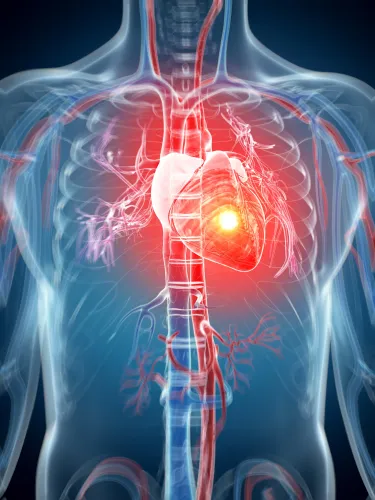
MI, pulmonary hypertension, and heart failure reporting will change beginning Oct. 1.
Chapter 9 of the ICD-10-CM is set for an extensive overhaul, which is sure to affect many internal medicine practices. As one in three American adults suffers from some form of heart disease, according to the American Heart Association, there’s a good change that cardiovascular dignoses make up a large part of your reporting
So, read on and find out how these three big changes will affect your documentation during the coming year.
Change 1: Record Unspecified MIs with New Codes …
The first big change is the renaming of the I21 series to Acute myocardial infarction and the addition of a new code, I21.9 (Acute myocardial infarction, unspecified). Prior to Oct. 1, you would report I21.3 (ST elevation [STEMI] myocardial infarction of unspecified site) for a myocardial infarction (MI) when the location was unspecified. The addition of I21.9 allows you to report an MI with an unspecified location with a distinct code to make your reporting easier, clearer, and more accurate.
… But Remember to ‘Code Also’ or ‘Code First’
The WHO has also introduced a new code series, I21.A- (Other type of myocardial infarction) and added two new subdivision codes, I21.A1 (Myocardial infarction type 2) and I21.A9 (Other myocardial infarction type). Each code has significant notes attached, but most important are the “code also” instructions that accompany both codes, and the “code first” instructions that accompany I21.A9.
Kent Moore, senior strategist for physician payment at the American Academy of Family Physicians, explains that when “code also” notes appear with a code, an additional code is necessary without regard to sequencing. On the other hand, “code first” notes, like “use additional code” notes, Moore explains, are “used as sequencing rules in the classification for certain codes that are part of an etiology/manifestation combination.”
Impact: This means that I21.A9, for example, can be a manifestation of I97.790 (Other intraoperative cardiac functional disturbances during cardiac surgery), which is why you would code I97.790 first, if applicable, according to Moore.
And Donelle Holle, RN, President of Peds Coding Inc., and a healthcare, coding, and reimbursement consultant in Fort Wayne, Indiana, cautions that following these conventions to the letter “is vitally important in obtaining proper reimbursement as well as decreasing your claim denials due to diagnosis issues.”
Coding scenario: A patient reports to your office for the first time after an acute stent thrombosis following a type 4a MI associated with percutaneous coronary intervention after cardiac surgery. Under the new ICD-10-CM changes, you would use the following three codes in this order:
In this scenario, you will need to pay attention to both the codes and the sequence for reporting them. This is because even though you are primarily reporting the type 4a MI (I21.A9), the note to the code requires you to report the postprocedural MI first. The code note also requires you to code the thrombosis, so you would add T82.867- to your reporting, adding a seventh digit, A (initial encounter), as this was the first visit. You could also use D (subsequent encounter), or S (sequela) depending on the circumstances.
Change 2: Watch the Major Overhaul to Pulmonary Hypertension Codes
The I27 (Other pulmonary heart diseases) series is also the recipient of numerous new codes, notes, Excludes1, and “code also” instructions. The biggest revisions are the subdivisions to I27.2 (Other secondary pulmonary hypertension), which include:
Coding scenario: Your provider sees a patient who has group 1 pulmonary hypertension caused by an HIV infection. You would record I27.21, as the note to that code reads “(Associated) (drug-induced) (toxin-induced) (secondary) group 1 pulmonary hypertension.” Following the “code also” instructions, you would then record B20 (Human immunodeficiency virus [HIV] disease) to complete the picture.
Change 3: Use these New 5-, 6-Digit Codes to Specify Heart Failure
One other major change to the way you will report cardiovascular care after Oct. 1 will involve use of a new code, I50.8- (Other heart failure), and its subdivisions, which will allow you to report types of heart failures, especially those involving the right ventricle, with greater specificity than before.
The main subdivisions include:
Also: There are further subdivisions for I50.81-, including I50.810 (... unspecified), I50.811 (Acute …), I50.812 (Chronic …) I50.813 (Acute on chronic …) and I50.814 (… due to left heart failure).
These changes, like the changes to the I27 codes, are “intended to capture and more discretely identify types of right heart failure and biventricular heart failure,” according to Moore, who goes on to observe that “ICD-10-CM 2018 is adding another layer of granularity to the system.” And, adds Holle, “this high level of specificity is also very important as it allows you stay away, as often as possible, from the unspecified codes, making it more likely you will be reimbursed appropriately.”
Coding scenario: Your provider documents a patient with right ventricular failure due to acute systolic congestive heart failure. The new ICD-10-CM changes will enable you to code this as I50.814, but the “code also” note requires you to report I50.21 (Acute systolic [congestive] heart failure) as the primary, left ventricular failure. But you’ll need to be careful not to report I50.82 (Right heart failure with but not due to left heart failure), which is now an Excludes1 for I50.814.
